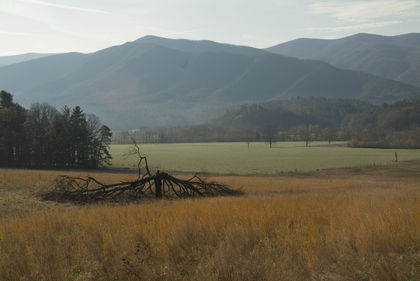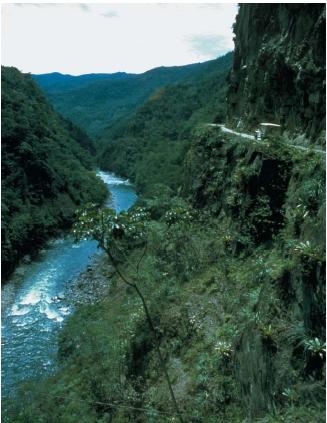Biosphere

The biosphere is the space on or near Earth's surface that contains and supports living organisms. It is subdivided into the lithosphere, atmosphere, and hydrosphere. The lithosphere is Earth's surrounding layer, composed of solids such as soil and rock; it is about 80 to 100 kilometers (50 to 60 miles) thick. The atmosphere is the surrounding thin layer of gas. The hydrosphere refers to liquid environments such as lakes and oceans that lie between the lithosphere and atmosphere. The biosphere's creation and continuous existence results from chemical, biological, and physical processes.
Requirements for life
For organisms to live, certain environmental conditions (such as proper temperature and moisture) must exist, and the organisms must be supplied with energy and nutrients (food). All the animal and mineral nutrients necessary for life are contained within Earth's biosphere. Nutrients contained in dead organisms or waste products of living cells are transformed back into compounds that other organisms can reuse as food. This recycling of nutrients is necessary because there is no source of food outside the biosphere.
Words to Know
Decomposition: The breakdown of complex molecules—molecules of which dead organisms are composed—into simple nutrients that can be reutilized by living organisms.
Energy: Power that can be used to perform work, such as solar energy.
Global warming: Warming of the atmosphere that results from an increase in the concentration of gases that store heat, such as carbon dioxide.
Nutrient: Molecules that organisms obtain from their environment; they are used for growth, energy, and various other cellular processes.
Nutrient cycle: The cycling of biologically important elements from one molecular form to another and back to the original form.
Photosynthesis: Process in which plants capture light energy from the Sun and use it to convert carbon dioxide and water into oxygen and organic molecules.
Respiration: Chemical reaction between organic molecules and oxygen that produces carbon dioxide, water, and energy.
Energy is needed for the functions that organisms perform, such as growth, movement, waste removal, and reproduction. It is the only requirement for life that is supplied from a source outside the biosphere. This energy is received from the Sun. Plants capture sunlight and use it to convert carbon dioxide and water into organic molecules, or food, in a process called photosynthesis. Plants and some microorganisms are the only organisms that can produce their own food. Other organisms, including humans, rely on plants for their energy needs.
The major elements or chemical building blocks that make up all living organisms are carbon, oxygen, nitrogen, phosphorus, and sulfur. Organisms are able to acquire these elements only if they occur in usable

chemical forms as nutrients. In a process called the nutrient cycle, the elements are transformed from one chemical form to another and then back to the original form. For example, carbon dioxide is removed from the air by plants and incorporated into organic compounds (such as carbohydrates) by photosynthesis. Carbon dioxide is returned to the atmosphere when plants and animals break down organic molecules (a process known as respiration) and when microorganisms break down wastes and tissue from dead organisms (a process known as decomposition).
Evolution of the biosphere
During Earth's long history, life-forms have drastically altered the chemical composition of the biosphere. At the same time, the biosphere's chemical composition has influenced which life-forms inhabit Earth. In the past, the rate at which nutrients were transformed from one chemical form to another did not always equal their transformation back to their original form. This has resulted in a change in the relative concentrations of chemicals such as carbon dioxide and oxygen in the biosphere. The decrease in carbon dioxide and increase in atmospheric oxygen that occurred over time was due to photosynthesis occurring at a faster rate than respiration. The carbon that was present in the atmosphere as carbon dioxide now lies in fossil fuel deposits and limestone rock.
Scientists believe that the increase in atmospheric oxygen concentration influenced the evolution of life. It was not until oxygen reached high concentrations such as exist on Earth today that multicellular organisms like ourselves could have evolved. We require high oxygen concentrations to accommodate our high respiration rates and would not be able to survive had the biosphere not been altered by the organisms that came before us.
Current developments
Most research on the biosphere is to determine the effect that human activities have on the environment—especially on nutrient cycles. Application of fertilizers increases the amount of nitrogen, phosphorus, and other nutrients that organisms can use for growth. These excess nutrients damage lakes, causing overgrowth of algae and killing fish. Fuel consumption and land clearing increase carbon dioxide levels in the atmosphere and may cause global warming (a gradual increase in Earth's temperature) as a result of carbon dioxide's excellent ability to trap heat.
Biosphere 2. Interest in long-term, manned space exploration has also generated research into the development of artificial biospheres. Extended missions into space require that nutrients be cycled in a volume no larger than a building. The Biosphere 2 Project, which received a great deal of popular attention in the early 1990s, provided insight into the difficulty of managing such small, artificial biospheres. The idea behind the project was to establish a planet in miniature where the inhabitants not only survived but learned to live cooperatively and happily together. This is quite revealing, given that human civilization has found it difficult to manage sustainably the much larger biosphere of planet Earth.
Gaia Hypothesis
The Gaia hypothesis (pronounced GAY-a), named for the Greek Earth goddess Gaea, is a recent and controversial theory that views Earth as an integrated, living organism rather than as a mere physical object in space. The Gaia hypothesis suggests that all organisms and their environments (making up the biosphere) work together to maintain physical and chemical conditions on Earth that promote and sustain life. According to the hypothesis, organisms interact with the environment as a homeostatic (balancing) mechanism for regulating such conditions as the concentrations of atmospheric oxygen and carbon dioxide. This system helps to maintain conditions within a range that is satisfactory for life. Although scientists agree that organisms and the environment have an influence on each other, there is little support within the scientific community for the notion that Earth is an integrated system capable of regulating conditions to sustain itself. The Gaia hypothesis is a useful concept, however, because it emphasizes the relationship between organisms and the environment and the effect that human activities have on them.
One of the most spectacular structures ever built, Biosphere 2 is located in the Sonoran Desert at the foot of the Santa Catalina Mountains not far from Tucson, Arizona. It is the world's largest greenhouse, made of tubular steel and glass, covering an area of three football fields—137,416 square feet (12,766 square meters)—and rising to a height of 85 feet (26 meters) above the desert floor. Within the structure, there is a human habitat and a farm for the Biospherians or inhabitants to work to provide their own food. There are five other wild habitats or biomes representing a savannah, a rain forest, a marsh, a desert, and an ocean. Biosphere 2 is completely sealed so no air or moisture can flow in or out. Nearby are two balloon-like structures that operate like a pair of lungs for Biosphere 2 by maintaining air pressure inside. Only sunlight and electricity are provided from outside.
On September 26, 1991, four women and four men from three different countries entered the Biosphere 2 and the doors were sealed for the two-year-long initial program of survival and experimentation. During this time, the Biospherians attempted to run the farm and grow their own food in the company of some pigs, goats, and many chickens. They shared the other biomes with over 3,800 species of animals and plants that were native to those habitats. The resident scientists observed the interactions of plants and animals, their reactions to change, and their unique methods of living. The Biospherians also had the assignment of experimenting with new methods of cleaning air and water.
On September 26, 1993, the Biospherians emerged from Biosphere 2. It had been the longest period on record that humans had lived in an "isolated confined environment." Unfortunately, the experiment did not live up to expectations. The Biospherians experienced many difficulties, including an unusually cloudy year in the Arizona desert that stunted food crops, rapid growth and expansion of some ant species, and unusual behavior of bees fooled by the glass walls of the structure. In 1996, Columbia University took over operation of the facility, opening a visitors' center later that year. Biosphere 2 has been maintained for study but without human inhabitants. Its future remains uncertain.
[ See also Atmosphere, composition and structure ; Gaia hypothesis ; Photosynthesis ; Respiration ]
great artical
and what is its origin?
how did it start and why?
and when did the hydrosphere start as well?